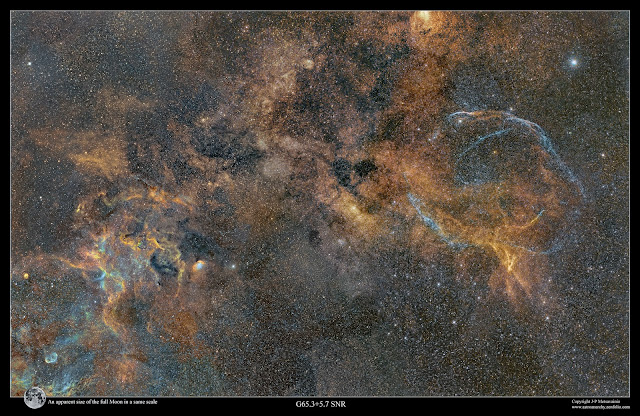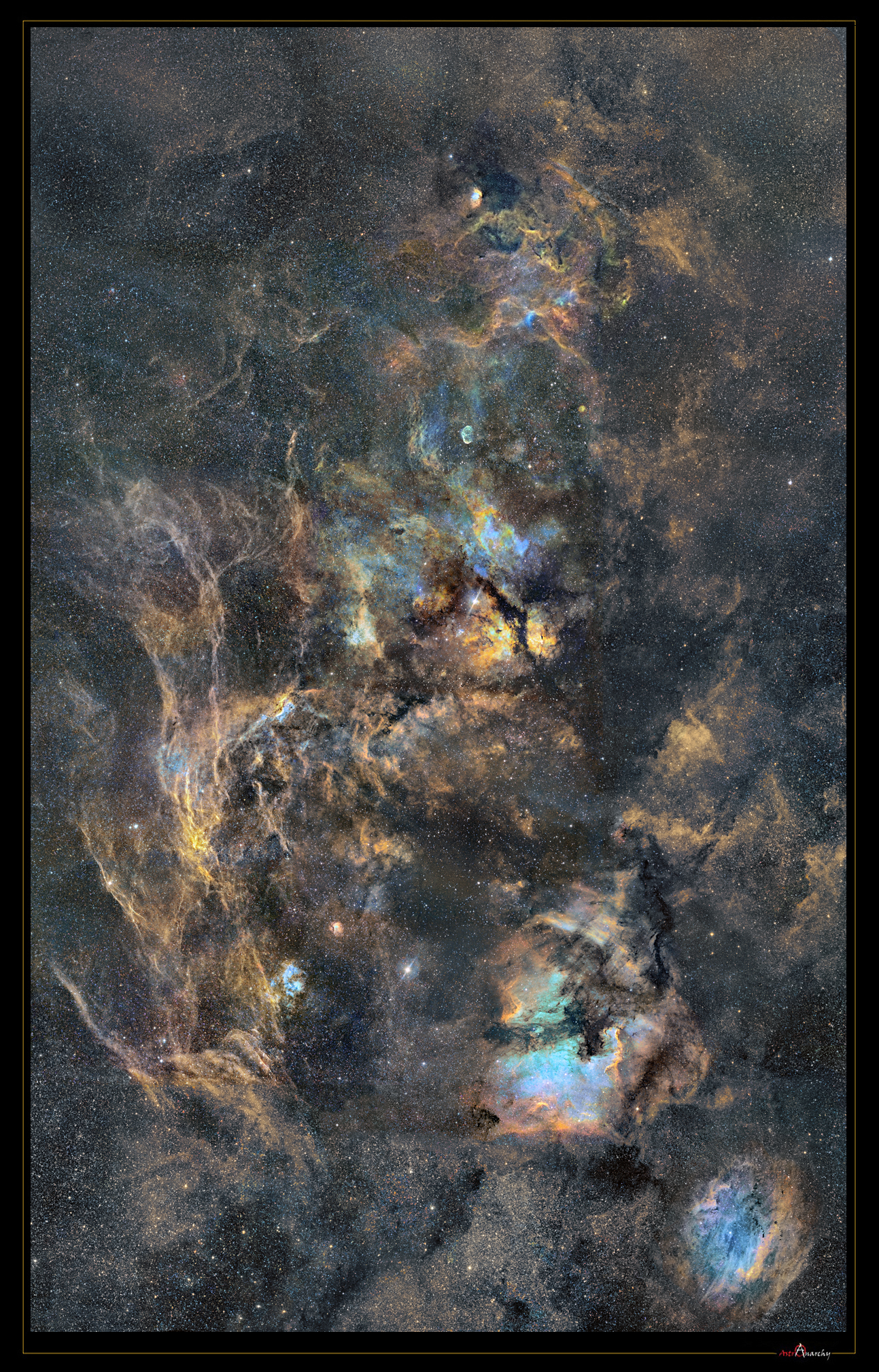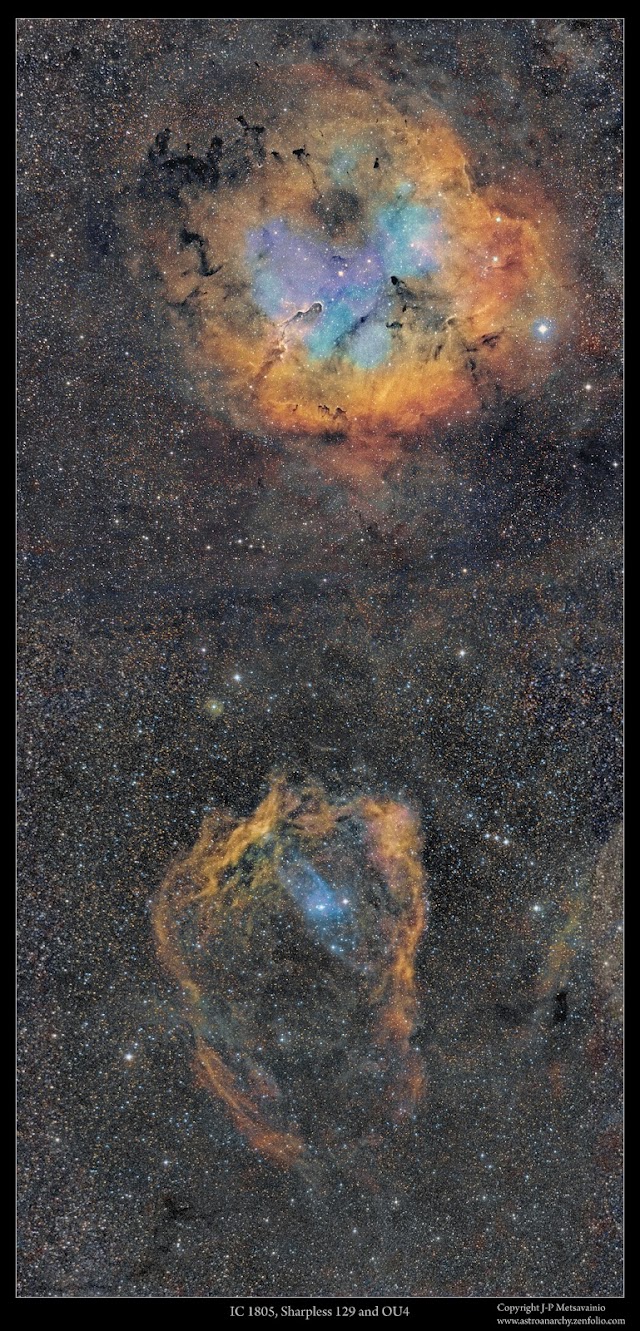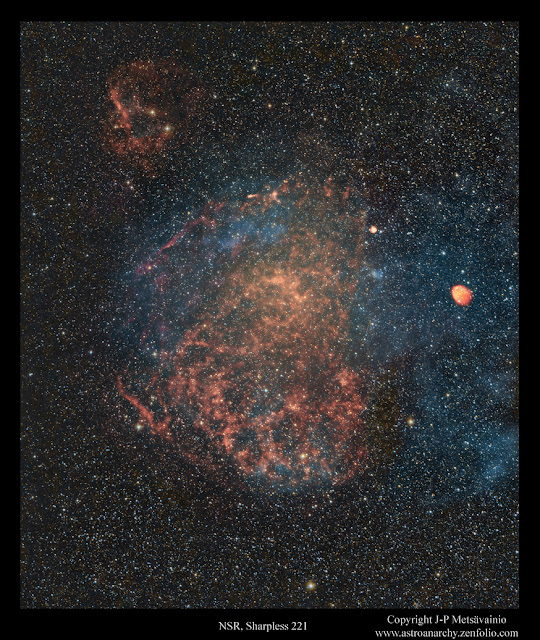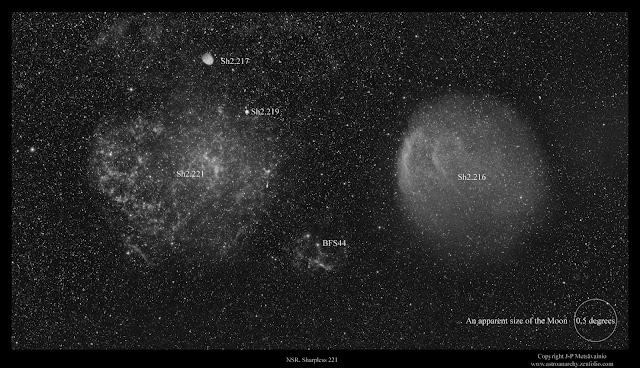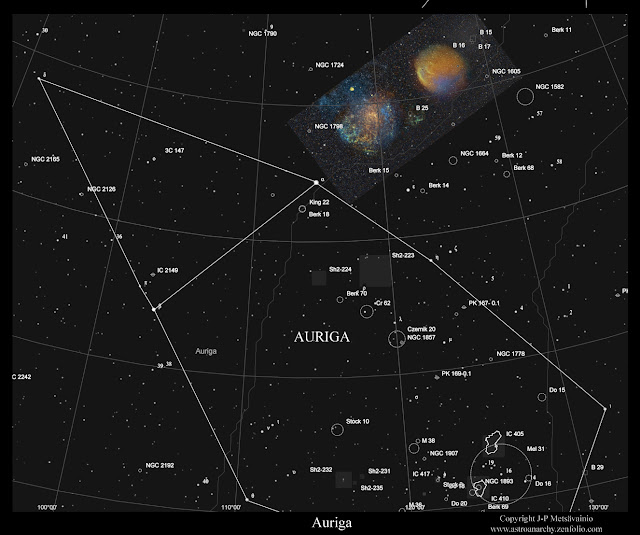COPYRIGHT, PLEASE NOTE
Tuesday, December 15, 2020
Cygnus project, ten years and 500 hours, the grande finale!
Total exposure time is way over 600 hours shot between 2010 and 2020. Some areas of this mosaic panorama required more exposure time than others. There are two large supernova remnants in this mosaic. both are large, diffused and very dim. I have used about 150 hours of exposures for them alone! There are hardly any deep and large enough photos around showing them well.
I have started this imaging project back at 2010. My aim was make a highish resolution mosaic covering the constellation Cygnus. Work like that takes time and patience, especially since I have worked so, that many of the individual sub mosaics or frames can be published as an individual artworks. Here is a poster format presentation about all of longer focal length images used for this mosaic beside actual panels, https://astroanarchy.blogspot.com/2018/11/treasures-of-swan.html
As a result I have now a huge 37 panel (And 58 long focal length sub-panel) mosaic panorama covering 28 x 18 degrees of sky. I have collected photons way over 500 hours during past ten years for this photo. The full size mosaic image has a size of about 25.000 x 15.000 pixels.
A photo of five million stars*
Great Mosaic of Cygnus (2010-2020)
28x18 degrees, 37 + 58 panels and over 600 hours of exposure time
The full size photo is worth to see! (2700 x 1700 pixels)
* I actually counted the stars and in this field of view there are little over five million individual stars
Three supernova remnants, two Wolf Rayet stars and a black hole
Please, click the image for full resolution
You should click the images to see them in full glory, it's worth the effort!
North America and the Pelican Nebula
Original size in mosaic image is 5000 x 2500 pixels
The supernova remnant G65.3+5.7 at top of the mosaic image
A closeup from the supernova remnant G65.3+5.7
The noise is not a noise, just a massive amount of stars
The blog post with technical details can be seen here, https://astroanarchy.blogspot.com/2020/10/the-tulip-nebula-in-cygnus-sh2-101.html
Cirrus of Cygnus
Blog post about this photo, https://astroanarchy.blogspot.com/2020/12/cirrus-of-cygnus-and-supernova-remnant.html
Click for a large image
NOTE I recalculated the total exposure time and it's actually way over 600 hours.
Here is a poster format presentation and a list all of longer focal length images used for this mosaic beside the actual panels, https://astroanarchy.blogspot.com/2018/11/treasures-of-swan.html
Beside three supernova remnants there are two Wolf Rayet stars with outer shell formations. NGC 6888, the Crescent Nebula at center of the image and the WR 134, it can be seen as a blue arch just right from the Crescent Nebula, near the Tulip nebula.
Next to the Tulip Nebula lays a Black hole Cygnus X-1, it's marked in small closeup image of the Tulip Neula at center right in orientation image above.
Constellation Cygnus is an endless source of celestial wonders, both scientifically and aesthetically. For me, as an visual artist, this are of night sky is very inspiring There are endless amount of amazing shapes and structures, I can spend rest of my life just shooting images from this treasury.
A funny anecdote
The answer was; "If you think about the swan, I just pointed out the anatomically correct location"
Monday, October 13, 2014
Cygnus panorama
A mosaic photo of constellation Cygnus in narrowband colors, R=Sulfur, G=Hydrogen and B=Oxygen. Note. The "noise" at background is not a noise but massive amount of stars!
Labeled
Click for a large image
Note. A relative size of the Moon is marked at lower Right corner
An original photo and processing, with the technical details, can be seen HERE
Wednesday, August 27, 2014
IC 1896 reprocessed
IC 1396
Click for a large image
R=Sulfur, G=Hydrogen and B=Oxygen
Technical data and more info can be seen HERE
A two frame mosaic image of IC 1396 with the Sharpless 129 and OU4, a planetary nebula candidate
A closeup of an Elephant's Trunk Nebula in IC 1396
Technical data and more info can be seen HERE
An experimental 3D-study of IC 1396 can be seen HERE
Naturally you can buy a museum quality photographic print from any of my images!
HERE is the portfolio with a shopping possibility.
Monday, March 24, 2014
A collection of large supernova remnants as a poster
Images are in mapped colors from the emission of ionized elements. NOTE a large image, 1900x2500 pixels and 6MB
R=Sulfur, G=Hydrogen and B=Oxygen.
Note. The Moon as a scale to show the apparent scale in the sky.
The same collection in visual spectrum
Click for a full resolution poster. NOTE a large image, 1900x2500 pixels and 6MB
Images are in Natural color palette from the emission of ionized elements,
R=Hydrogen + Sulfur, G=Oxygen and B=Oxygen + Hydrogen. This is very close to a visual colors.
Note. The Moon as a scale to show the apparent scale in the sky.
More information about SNR images above
Links to my original photos with technical details
- Simeis 147: http://astroanarchy.blogspot.fi/2012/02/siemis-147-new-data-added.html
- IC 443: astroanarchy.blogspot.fi/2012/03/supernova-remnant-ic-443.html
- Sharpless 224: http://astroanarchy.blogspot.fi/2011/01/reprocessed-supernova-remnants.html
- Sharpless 221: http://astroanarchy.blogspot.fi/2014/01/sh2-221-supernova-remnant-in-auriga.html
- The Veil Nebula: http://astroanarchy.blogspot.fi/2013/12/veil-nebula-unveiled.html
- G65.3+5.7SNR: http://astroanarchy.blogspot.fi/2013/12/an-other-supernova-remnant-in-cygnus.html
- The Crab Nebula, M1: http://astroanarchy.blogspot.fi/2010/03/m1-crab-nebula-finalized.html
Monday, February 10, 2014
All my images from the Spring season 2014
Sunday, February 2, 2014
A poster format collection from the Cepheus project
The Cepheus project was my last published image before the major break down of my imaging equipment.
All images are in mapped colors from the emission of ionized elements, R=Sulfur, G=Hydrogen and B=Oxygen.
An Original blog post of The Cepheus project can be seen HERE.
Small images clockwise, starting from the top left
- Cave Nebula, a closeup: http://astroanarchy.blogspot.fi/2012/12/the-cave-nebula_9.html
- Cave Nebula, a wide field shot: http://astroanarchy.blogspot.fi/2011/01/sh2-155-cave-nebula-reprocessed.html
- Sharpless 140: http://astroanarchy.blogspot.fi/2012/02/dim-and-large-nebula-in-cepheus.html
- Sharpless 129: http://astroanarchy.blogspot.fi/2013/12/a-start-of-new-project-cepheus-mosaic.html
- Elephant's Trunk Nebula: http://astroanarchy.blogspot.fi/2012/12/elephants-trunk-nebula-reprocessed.html
- IC 1396: http://astroanarchy.blogspot.fi/2011/10/ic-1396-home-of-elephants-trunk-nebula.html
- Sharpless 132, a wide field shot: http://astroanarchy.blogspot.fi/2011/02/sh2-132-project-finalized.html
- Sharpless 132, a closeup: http://astroanarchy.blogspot.fi/2013/10/the-second-image-of-autumn-season-2013.html
- The Wizard Nebula: http://astroanarchy.blogspot.fi/2011/07/sh2-142-wizard-nebula-reprocessed.html
- Sharpless 157: http://astroanarchy.blogspot.fi/2011/03/sh2-157-reprocessed.html
- Bubble Nebula: http://astroanarchy.blogspot.fi/2011/03/bubble-nebula-reprocessed.html
Wednesday, January 29, 2014
Three wide field projects, three constellations
Mapped colors from the emission of ionized elements, R=Sulfur, G=Hydrogen and B=Oxygen.
Total exposure time around 70 hours. Buy a photographic print from HERE
A blog post about this photo with more info and images:
http://astroanarchy.blogspot.fi/2012/03/auriga-panorama-gets-bigger-12-panels.html
10-panels mosaic of the constellation Cepheus
Click for a large image, Note. 2900x1700 pixels and 6,6MB
Mapped colors from the emission of ionized elements, R=Sulfur, G=Hydrogen and B=Oxygen.
Total exposure time around 92 hours. Buy a photographic print from HERE
A blog post about this photo with more info and images:
http://www.astroanarchy.blogspot.fi/2014/01/a-grande-finale-of-cepheus-project.html
(I have done many smaller mosaic images but only the very large ones are listed here.)
Tuesday, January 28, 2014
A grande finale of the Cepheus project, mosaic of ten panels with colors
Thursday, January 23, 2014
A supernova remnant in Cygnus (Not a Veil nebula) reprocessed
This is a rarely imaged target. I haven't been able to find an other color image of it, showing the whole supernova remnant. This is also one of the most difficult targets, I have ever shot. Due to a very dense star field, large angular dimension and a very diffused structure this is even more difficult target, than a Simeis 147 supernova remnant in Taurus. Total exposure time of 38h was needed to have this image.
NOTE, this image is updated at 20.01.2014. There is now a better H-a channel and the background is practically full of ionized Hydrogen, H-alpha.
A bicolor image of the supernova remnant. An ionized Hydrogen emission (H-alpha) can be seen as Red and an ionized Oxygen emission (O-III) as Blue. Buy a photographic print from HERE
So many stars...
A closeup from the full resolution image, click to see it at maximum size.
Tuesday, January 21, 2014
Sh2-221, a supernova remnant in Auriga
I have shot this area before but at the time part of the Sh2-221 was missing. This new image of mine is much more accurate and deep.
Mapped colors
Visual spectrum
A two panel mosaic image of Sh-221 and Sh2-216
Two ways to end a life of the star in a same seven degrees field of view!
Visual spectrum
Buy a photographic print from HERE
A labeled image
Note. A circle, size of the Moon, is marked as a scale. Both objects are very large targets, as can be seen.
Orientation in Auriga
Exposures for the Sh2-221 SNR
H-alpha: 51 x 1200s = 17h
O-III: 21 x 1200s = 7h
S-III: 27 x 1200s = 9h
Exposures for the Sh2-216 Planetary Nebula
H-alpha: 30 x 1200s = 10h
O-III: 18 x 1200s = 6h
S-III: 27 x 1200s = 9h
Animation of the narrow band channels
A set of individual 20 min. exposures for used channels.
H-alpha, the light emitted by an ionized Hydrogen
A single 20 min. exposure of H-alpha
S-II, the light emitted by an ionized Sulfur
A single 20 min. exposure of S-II
O-III, the light emitted by an ionized Oxygen
A single 20 min. exposure of O-III





